Weighing up to more than two tons, Doedicurus clavicaudatus, sometimes known as the morning star-tailed glyptodon, was one of the last and largest members of its family. Like most other prehistoric jumbo armadillos, it featured a heavy domed carapace and an armoured tail, but in its case, the tail was extra long and terminated in a thick club that probably bore spikes. Essentially then, Doedicurus was the mammalian equivalent of Ankylosaurus. And just as that dinosaur’s armament protected it against Tyrannosaurus rex, Doedicurus‘ would have been an effective deterrent against even the biggest and hungriest Smilodon.
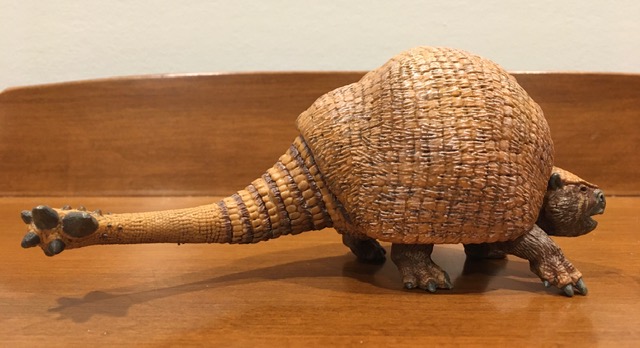
A Doedicurus is CollectA’s sole prehistoric mammal for 2021. Measuring about 17.5 cm long and 7.5 cm tall at the peak of its carapace, it is posed in a walking stance with its mouth open, left forepaw raised, and tail swinging to the right. Could be that this individual is just waddling placidly across the South American grasslands on a quiet sunny day, or maybe it’s squaring off with a rival over mating rights (assuming this is supposed to be a male). Or, of course, it’s bravely defending itself against either a marauding sabretooth or a short-faced bear or a jaguar or some other Pleistocene predator.
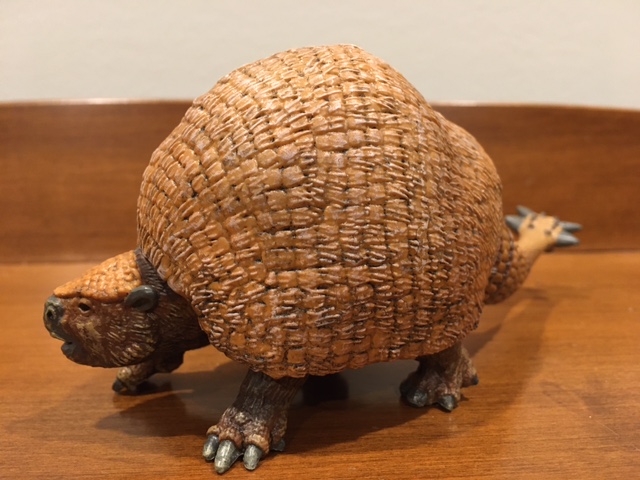
Interestingly, while the Doedicurus‘ carapace is made of the usual solid PVC, the rest of its body uses a noticeably softer material. The head, forelimbs, and belly even give a little bit when squeezed. This makes the toy much lighter than it looks, and undoubtedly increases its durability as well. And it certainly doesn’t take away from the sculpting detail of this beast.
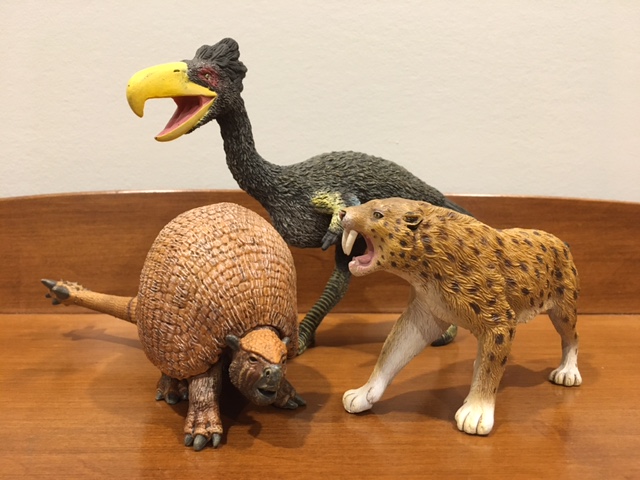
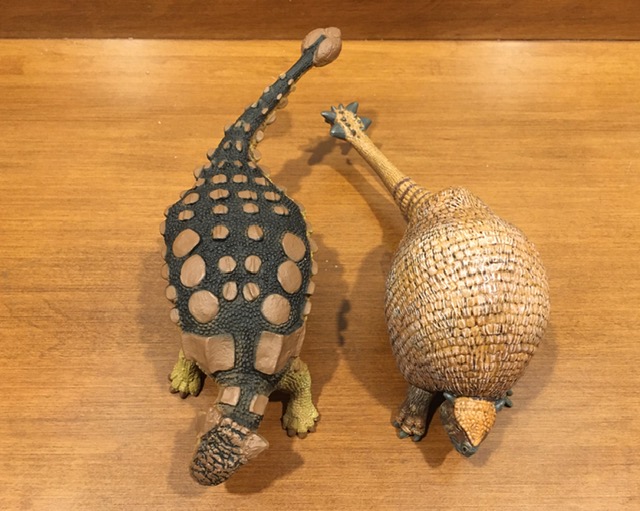
The Doedicurus‘ head, limbs, and belly are coloured dark brown with light brown wash, dark grey for the claws, muzzle, and ears, black for the eyes and nostrils, and light pink for the tongue visible inside the open mouth. The cranial armour, carapace, and tail, meanwhile, are a shade of orange-brown. Faint dark brown wash accentuates the osteoderms and the joints in the armour segments on the tail and the spikes at the tip. It is a fitting colour scheme for a gargantuan armadillo, and a beautifully applied one at that.
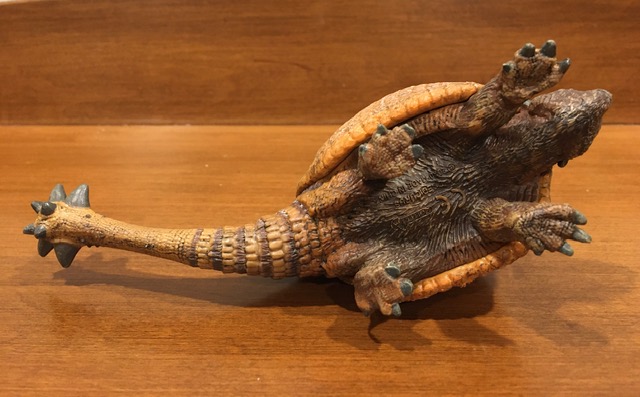
The non-armoured parts of the Doedicurus are covered in short fur save for the feet and muzzle. Whereas modern armadillos have long, curved front claws for digging out food or burrows, the ones on this titan are comparatively shorter and more rounded, reflecting its grazing lifestyle. The same goes for the short and rounded skull. The carapace has the correct shape, with a high, rounded dome and a slight dip toward the rear. While the osteoderms comprising the carapace would be impressive enough on their own, what really makes this figure stand out are the countless strands of hair that can be seen growing among the osteoderms. They may seem a bit odd at first, but glyptodonts have on occasion been depicted in paleoart with such features. Moreover, many extant armadillos have visible hair on their carapaces, so it is plausible that Doedicurus and its brethren were the same.
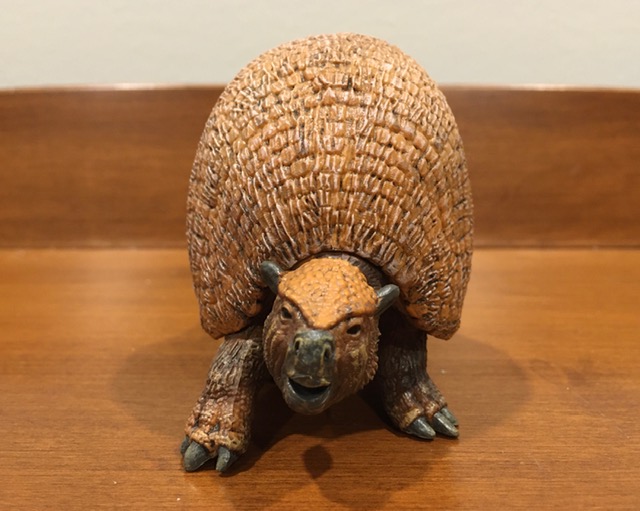
The Doedicurus‘ tail correctly features six bands covered in large osteoderms followed by a long section covered in much smaller osteoderms, and finally a large, rounded club adorned with a multitude of spikes. These are largely speculative, as all existing fossil tail clubs only show shallow depressions which could have housed spikes. Whereas some restorations of Doedicurus have featured long, thin, and pointed spikes, CollectA’s version has short and stout ones with blunted tips. The reasoning behind this is that the primary purpose of the tail club appears to have been for intraspecific combat, to establish dominance or win mating rights. This is supported by specimens with deep dents on their carapaces that were probably caused by blows inflicted from rivals. Long, thin, and pointed spikes would not have held up to such regular blunt force, but short, stout, and blunt ones would. They also would still have been potentially devastating against would-be predators.

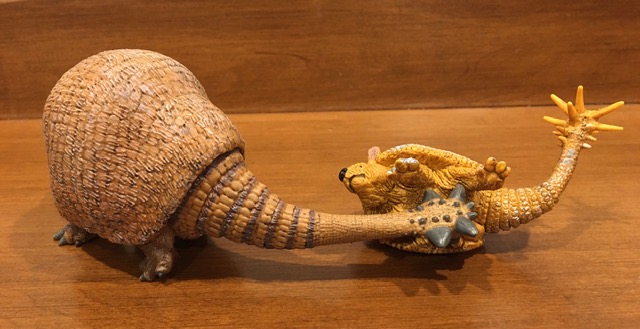
Doedicurus is one of the most iconic Cenozoic beasts and CollectA has done real justice to it with this toy. It is satisfyingly big, scientifically accurate, quite durable, and wonderfully sculpted, making it a definite must-have in my opinion. Update 04/16/22: the Doedicurus was voted Best Non-Dinosaur Figure of 2021 by readers of The Prehistoric Times magazine! Congratulations, CollectA! Fingers crossed for more magnificent megafauna of South America from them in the future. Megatherium and Arctotherium would be my top picks!
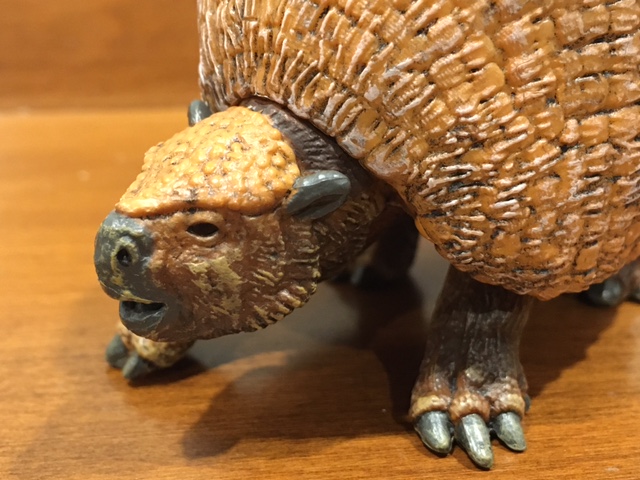
Disclaimer: links to Ebay and Amazon on the DinoToyBlog are affiliate links, so we make a small commission if you use them. Thanks for supporting us!




Just got my Collecta Doedicurus today and it was well worth the wait. The attention to accuracy in the sculpting is quite apparent by designer Anthony Beeson. In fact it was the only new prehistoric animal figure purchased this year and only wish other companies like Safari, Schleich, and Papo would follow this example. Eofauna was (past tense) producing some incredible early proboscidean figures but obviously they have sold out that commitment and are focusing only on dinosaurs of late. A figure as perfect as this Doedicurus kindles some hope for more mammal species in the future.
I don’t think it’s fair to say that EoFauna has “sold out” on anything. They’re a fledgling company and they’re working (correctly) to expand their appeal. Dinosaurs are always going to sell better than Cenozoic beasts; that’s a business rule set in the most solid stone. But I think it’s safe to assume that EoFauna will produce more of the latter in the future.
And indeed we’ve got a konobelodon. 😀 And I’m pretty sure we’ll get many more proboscideans in the future.
This is an amazing figure! But I have to admit, I really like the Safari figure and so I will keep the latter in my collection and not pursue the CollectA one (besides the CollectA looks to be a bit big for my tastes). But still, impressive model!
I like this one in large part because it is so big. Doedicurus was a huge animal, after all, about the size of a small car. The Safari one always struck me as too puny to do the animal justice.
Nagyon szép és pontos,azonban a
Safaris marad a kedvencem.Vettem kettőtt,így tudnak akár párbajozni
vagy csordát alkotni.Ő a kedvenc Glyptodont figurám.
A Safari több mint tíz évvel ezelőtt kiadta a Doudicurust,és még mindig jobban tetszik mint ez.
Great to see a review of this amazing model!
Wonderful review and great to see it with some other figures.
By far the best prehistoric mammal from CollectA!
Thanks!
Like your “KO!” picture… the Safari one is a very good toy, but I never really could get me to like the head sculpt, looked too much like a bunny to me. CollectA really brought it home with this one, can`t wait till it hits Germany.
Yes, I enjoyed the Safari one, but this new CollectA definitely clobbers it (pun intended). I passed down the former to my son’s collection.
I’ve been looking forward to this one since I first heard it announced. Glad to see Collecta did a great job on it. Can’t wait for July.
Without a doubt the doedicurus and even the giant armadillo that I have always wanted to have. Recommended figure for all of us who are lovers of prehistoric mammals. The one from Collecta is the best doedicurus of its kind so far hard to beat in the toy dinosaur market. I really like its durability and that the extremities are made of a less rigid plastic, a combination of a rigid material and a lighter and more elastic material is good. Bravo Collecta!